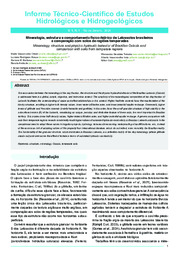Mineralogia, estrutura e comportamento físico-hídrico de Latossolos brasileiros e comparação com solos de regiões temperadas.
Mineralogia, estrutura e comportamento físico-hídrico de Latossolos brasileiros e comparação com solos de regiões temperadas.
Autoria: OTTONI, M. V.; SOUZA, L. R.; BARBOSA, S. M.; ANDRADE, R.; TEIXEIRA, W. G.; INDA, A. V.; CURI, N.
Resumo: The association between the mineralogy of the clay fraction, the structure and the physico-hydraulic behavior of the Brazilian Latosols (Oxisols) is addressed here in a global, simple, objective, and instructive context. The simplicity of the mineralogical composition of the clay fraction of Latosols facilitates the understanding of cause and effect relationships in this context. Higher kaolinite contents favor the manifestation of the blocky structure, resulting in higher bulk density values, lower water infiltration rates, and lower potential aquifer recharge. Conversely, higher levels of gibbsite and Fe-oxide minerals (mainly hematite and goethite), in this order, favor the small granular structure of high stability in the subsurface horizon (B) of the Latosols, constituting an unique, peculiar, and distinctive feature of these soils, the most important in Brazilian territory. This implies lower bulk density values, higher water infiltration rates, and higher potential aquifer recharge. A generic comparison with soils from temperate regions reveals consistently much higher values of saturated hydraulic conductivity in Brazilian Latosols and points to the unequivocal need to adopt these values in irrigation projects, hydrology, terraces dimensioning, waterproofing of landfill bottoms, etc., instead of the enormous risk of adopting values of this property from international literature, which do not reflect, even remotely, the Brazilian reality. The functionality of the granular structure, which dominates in Brazilian Latosols, is a reflection mainly of the clay mineralogy (where gibbsite stands out) and overcomes the effect of texture in terms of saturated hydraulic conductivity.
Ano de publicação: 2024
Tipo de publicação: Folhetos
Unidade: Embrapa Solos
Palavras-chave: Estrutura do Solo, Mineralogia, Mineralogy, Oxisol, Oxisols, Soil structure, Solos Temperados, Temperate soils
Observações
1 - Por padrão são exibidas publicações dos últimos 20 anos. Para encontrar publicações mais antigas, configure o filtro ano de publicação, colocando o ano a partir do qual você deseja encontrar publicações. O filtro está na coluna da esquerda na busca acima.
2 - Para ler algumas publicações da Embrapa (apenas as que estão em formato ePub), é necessário ter, no celular ou computador, um desses softwares gratuitos. Sistemas Android: Google Play Livros; IOS: iBooks; Windows e Linux: software Calibre.
Acesse outras publicações
Acesse a Base de Dados da Pesquisa Agropecuária (BDPA) para consultar o acervo completo das bibliotecas da Embrapa.

